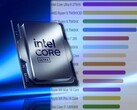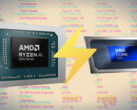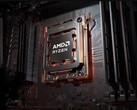An arguably unexpected graph has been shared by PassMark that charts the year-on-year performance changes for average CPU Mark, the benchmark test suite that processors are put through on the site. As can be seen in the graph, PassMark has been collating data since 2004 and there has been an increase in average performance for every year since in both laptop and desktop processors. The increase between 2019 and 2020 for laptop processors was only 0.5%, but it was still an improvement. But so far for 2025, there has been a disconcerting deceleration for both computer types in terms of average CPU Mark result.
Of course, it is worth mentioning now that PassMark is comparing the first month-and-a-half of 2025 with the whole 12 months of 2024, so it is possible the downward trend could be reversed by the end of the year. However, an X post from the benchmark site does state that “they don’t remember seeing this effect in past years”, despite a likely increase in high-end computer sales taking place in November and December. According to PassMark’s data, average desktop CPU performance has slipped by -0.5% (47,810 samples vs. 186,053 in 2024) while average laptop CPU performance has declined by -3.4% (25,541 samples vs. 101,316 in 2024).
It would be too ingenuous to immediately point a finger at AMD and Intel and cry foul in terms of generational performance gains. There are a few reasons why the graph could have witnessed its first decline in over 20 years that would not be directly linked to Team Red and Team Blue. PassMark offers reasons such as sales of cheaper hardware, a trend to buying more power-efficient machines, bloatware issues, and even potential performance losses caused by operating systems. But spikes driven by desktop chips like the Intel Core i9-7980XE (+71.9%), Ryzen Threadripper 3970X (+96.1%), and Ryzen Threadripper PRO 7995WX (+58.6%), and laptop parts such as the Intel Core i9-12900HX (+42.8%) and AMD Ryzen 9 7945HX3D (+69.9%), are conspicuously missing in 2025 so far.
There is another obvious potential explanation here, which runs parallel to how RTX 50 series GPUs don’t seem to offer the same generational performance gains that their predecessors delivered, and why CPU families like Intel’s Arrow Lake and AMD’s Granite Ridge and Strix Point don’t appear to have lit up the average performance charts. It can be argued that raw CPU performance is no longer of critical importance to Team Blue and Team Red, especially as GPUs and other computer components have become more capable. Not every consumer wants a faster CPU; users want features like mobility, long battery life, AI integration, and overall efficiency over pure speed. Additonally, some gamers would rather spend their money on the latest and greatest from Nvidia than upgrade their CPU, especially if there is a Zen 3 or Zen 4 Threadripper already in place anyway.















